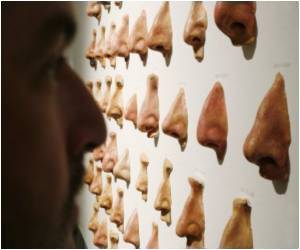Research has already shown that differentiating smells is no problem for the human nose.
Research has already shown that differentiating smells is no problem for the human nose.
How the olfactory organ distinguishes such similar smells has been uncovered by an interdisciplinary team of researchers at the RUB. The scientists were the first to shed light on the dynamics of the three-dimensional structure of the binding site of an olfactory receptor. In so doing, they also found a characteristic pattern of hydrogen bonds between odorant and receptor, which accounts for the specificity of the olfactory sensors. Using computer simulations, the RUB team was able to predict whether odorant molecules activate a certain receptor or not. "A dream of science and industry is coming true" says smell expert Prof. Dr. Dr. Dr. Hanns Hatt (Department of Cell Physiology). The study was chosen as cover story of the journal
Angewandte Chemie International Edition.
Computer model and living cells
The human nose has about 350 different types of olfactory receptors, each specialising in one or a few smells. "The receptor is like a door lock which can only be opened by the right key" says Dr. Lian Gelis from the Department of Cell Physiology. How the lock is exactly constructed was previously unknown. To solve the puzzle, Dr. Steffen Wolf and Prof. Dr. Klaus Gerwert (Department of Biophysics) set out by creating a computer model of the human olfactory receptor for the smell of apricots. In the model, they mutated several components (amino acids) in the binding site of the protein and predicted whether these receptor variants bind apricot fragrance or not. Gelis und Hatt then verified these predictions using "Ca2+-imaging" on the receptors in the physiological system.
Tango of the molecules
In this way, the researchers showed how the binding site has to be structurally constituted so that the apricot fragrance activates the receptor. Using molecular dynamics simulations, they then analysed the two binding partners in greater depth. They found that, in the dynamic interplay of the interaction between receptor and odorant molecule, specific chemical bonds, called hydrogen bridges, form and separate. "It's like a tango, where the female dancer constantly separates from her partner and joins him again at another point" explains Gerwert. "The receptor uses the dynamic hydrogen bonding pattern to distinguish between activating and non-activating odours."
Predictions for other olfactory receptors
The researchers established how many molecular junctions the interaction partners have to form in order for a smell to activate an olfactory receptor. They also managed to specifically manipulate a receptor protein in the model and in the experiment so that it detected papaya fragrance instead of apricot fragrance. "The findings can help to generate specific 'super-olfactory sensors' for a defined fragrance" says Hatt. "Since olfactory receptors not only occur in the nose, but also in many other tissues in the human body, for example in the prostate, in sperm, and in the intestines, the results may help to develop novel therapeutic approaches". The work was carried out as part of the Collaborative Research Centre SFB 642. The Mercator Foundation supported Prof. Gerwert with a grant.
Source-Eurekalert

 MEDINDIA
MEDINDIA




 Email
Email




